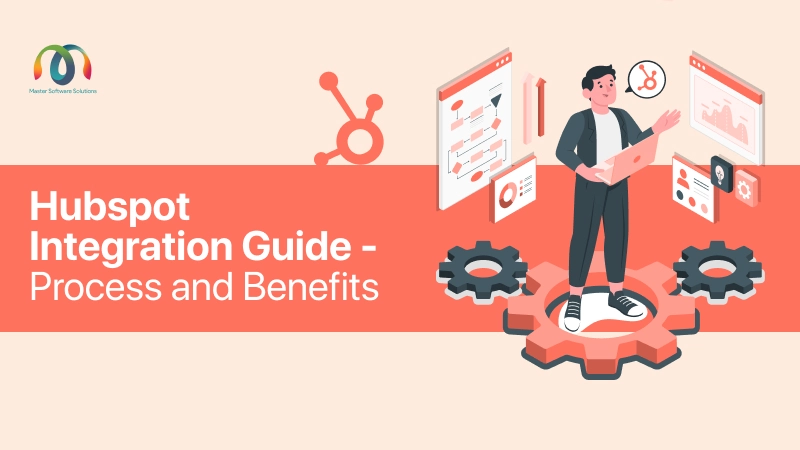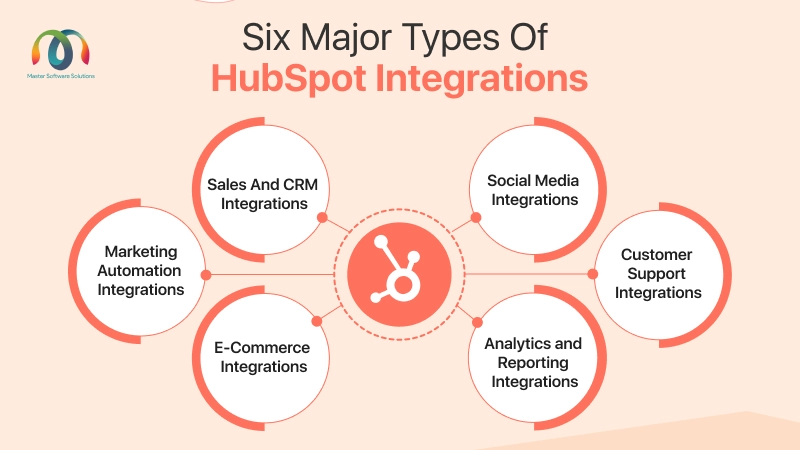Hubspot Integration Guide – Process and Benefits

Are you ready to transform your business operations by integrating HubSpot with your existing tools and systems?
This blog will take you on a comprehensive tour of the HubSpot integration process, beginning to end. Whether you are a seasoned HubSpot user or just getting started, understanding the intricacies of integration can help you realise the full potential of this robust platform.
What is HubSpot integration?
HubSpot integration connects different platforms, tools, or systems organisations use with the HubSpot CRM (customer relationship management) platform. These integrations ensure smooth data transfer and functionality, creating a unified and comprehensive view of customer interactions and activities.
You can use API (Application Programming Interface) connections, webhooks, and third-party integration platforms for these integrations. HubSpot integration aims to streamline business processes, improve data accuracy and consistency, and increase efficiency and productivity.
HubSpot integration can entail connecting HubSpot CRM to other marketing automation tools, email marketing platforms, customer support systems, and e-commerce platforms. It allows businesses to consolidate customer data, automate workflows, and gain valuable insights into customer behaviour and interactions.
HubSpot integration is a powerful way to improve the capabilities of HubSpot CRM and other tools, allowing businesses to provide a more personalised and seamless customer experience across multiple touchpoints.
Process for HubSpot integrations
HubSpot integrations require careful planning, configuration, and testing to ensure a successful integration that meets the organisation’s needs and goals.
The process for HubSpot integrations typically involves several key steps:
- Assessment of needs – The first step is to assess the organisation’s specific integration requirements. The process includes identifying the systems or tools needed for integration with HubSpot and the data and processes.
- Selection of integration method – Depending on the systems involved, the integration method may differ. HubSpot provides integration options, including direct integrations, API connections, webhooks, and third-party integration platforms. The best method is selected based on data volume, complexity, and the desired level of automation.
- Configuration and setup – After selecting an integration method, the next step is to configure the integration. The process includes creating API keys, setting up webhooks, or configuring settings on the third-party integration platform.
- Data Mapping – This process includes mapping the data to the corresponding fields of HubSpot. For example, consider mapping contact information from the CRM system to HubSpot’s contact field.
- Testing – Before you start the integration process, conduct testing to ensure seamless data flow between the systems and functionalities like automation rules or workflows are working as expected.
- Launch and monitoring – Launch the platform for use. You must monitor integrations to ensure they continue to work correctly and make necessary adjustments as per requirements.
- Optimisation – Optimisation is necessary to meet the organisation’s needs and goals. The process may include refining data mapping, adjusting automation rules, or incorporating new features released by HubSpot.
Read More – What are Hubspot Onboarding Services?
Benefits of integrating other platforms with HubSpot
Integrating other platforms with HubSpot offers benefits that significantly enhance your business operations and outcomes. You can increase collaboration and communication, expedite procedures, and give customers a more effective and customised experience by integrating other platforms with HubSpot.
Here are some key benefits:
- Centralised data – Centralise your customer data on the HubSpot platform to provide a single source of information for customer interaction and activities. Centralising the data gives easy access to and management of customer data, leading to accurate reporting and decision-making.
- Improved efficiency – Integration tools streamline business processes to reduce manual data entry, saving time and increasing productivity. For example, integrating the CRM platform with HubSpot enables the sales team to access customer information directly from HubSpot, eliminating the need to switch between the platforms.
- Enhanced communication – Integrations give up-to-date information access to the teams for seamless communication between the systems. Good communication fosters collaboration and coordination, which enhances customer service and launches successful marketing campaigns.
- Personalised customer experience – You can collect and analyse data from multiple sources to create personalised and targeted marketing campaigns. For example, email marketing integrations allow you to send targeted emails based on customer behaviour and preferences.
- Improved reporting and analytics – Combining data can help you create comprehensive reports and analytics, providing a holistic view of your business and allowing you to identify trends and opportunities.
- Enhanced automation – You can automate your repetitive tasks and workflows, freeing up time for your team and allowing you to focus on more strategic activities. For example, integrating a support system with HubSpot can automate the creation of support tickets based on customer interactions.
What are the platforms that you can integrate with HubSpot?
Businesses can integrate their HubSpot account with other tools and platforms thanks to the extensive set of APIs and integration options provided by HubSpot.
Several well-known systems that are compatible with HubSpot integrations are:
- Sales and CRM platforms
- Marketing automation
- E-commerce Platforms
- Content Management Systems (CMS)Social media platforms
- Advertising and PPC platforms
- Event management platforms Customer support and helpdesk tools
- Analytics and reporting platforms
- Project management tools
- Billing and invoicing tools
- Email and communication tools.
- E-signature solutions webinar and video conferencing tools
- Customer feedback and survey platforms
Types of approaches for HubSpot integration
Depending on the needs of the business, there are multiple ways to integrate HubSpot with other platforms or tools. When deciding on an integration approach, consider the level of customisation required, the real-time nature of data exchange, your team’s technical capabilities, and the availability of pre-built solutions or third-party platforms such as Zapier.
Here are some common approaches to HubSpot integration:
1. Direct API integration
- HubSpot API (Application Programming Interface) includes direct communication between HubSpot and the other tool platforms. Integrations can help you exchange data between the systems, making conversations possible.
- You can design custom integrations with HubSpot’s API to meet your needs. This methodology offers an elevated degree of adaptability and permits complete command over the integration procedure.
2. Pre-built Integrations:
- There are numerous well-known platforms and tools for which HubSpot has pre-built integrations. HubSpot or reliable partners frequently create and manage these integrations.
- Since pre-built integrations usually include predefined features and configurations, they can save time and effort. The HubSpot integrations with Salesforce, Mailchimp, and Shopify are a few pre-built integrations.
3. Zapier Integration:
- A third-party platform called Zapier makes it easier to integrate different software programs. Without writing any code, it enables you to create Zaps—automated workflows—that connect various apps.
- You can make Zaps that automate tasks between HubSpot and other apps, like Google Sheets, Slack, Trello, and more, thanks to HubSpot’s integration with Zapier.
3. Custom Webhooks and Webhooks-based Integrations:
- Apps can communicate in real time with other apps or web services using webhooks. You can configure HTTP endpoints to receive data from HubSpot and take actions based on that data because HubSpot supports custom webhooks.
- Webhooks can create unique integrations that adhere to specifications. For example, you can set up a webhook to receive notifications of new leads in HubSpot and then route that data to a custom internal system.
4. Data Import and Export:
- In some cases, you may not require real-time integration. Instead, you can use HubSpot’s import and export capabilities to transfer data between HubSpot and other platforms.
- The approach is suitable for one-time or periodic data transfers, such as importing contact lists, exporting marketing analytics data, or syncing data between HubSpot and an offline system.
5. HubSpot App Marketplace:
- Installing third-party apps and integrations that increase HubSpot’s functionality is possible through the marketplace HubSpot provides. Third-party developers created these apps, which you can quickly add to your HubSpot account.
- Many categories, including analytics, customer support, e-commerce, marketing automation, productivity, and more, are available in the HubSpot App Marketplace.
6. Custom Integrations with the HubSpot Integrations API:
- HubSpot’s Integrations API offers developers tools and resources to create custom integrations between HubSpot and other platforms. This approach enables deep, tailored integrations that address specific business requirements.
- Developers can use the Integrations API to access HubSpot CRM data, automate marketing workflows, sync data between HubSpot and other systems, and more.
Types of HubSpot integrations
HubSpot, a popular customer relationship management (CRM) and marketing automation platform, provides integrations that expand its functionality and enable users to connect with other tools and services. HubSpot’s flexible API and extensive integration capabilities allow businesses to connect their CRM and marketing automation workflows with other tools and services, resulting in a more seamless and efficient customer experience.
Here are six major types of HubSpot integrations:
1. Sales and CRM integrations
HubSpot integrates with CRM platforms, including Salesforce, Microsoft Dynamics, and others. These integrations help streamline sales processes by synchronising contacts, deals, and other data between the CRM and HubSpot, ensuring that the sales and marketing teams access the same information.
2. Marketing automation integrations
HubSpot integrates with several marketing automation platforms, including Marketo, Eloqua, and Pardot. With these integrations, marketers can automate lead nurturing, email marketing, and other marketing activities across multiple platforms while maintaining a unified view of customer interactions.
3. E-commerce integrations
HubSpot integrates with popular e-commerce platforms such as Shopify, Magento, and WooCommerce. These integrations enable businesses to sync customer data, monitor e-commerce performance, and create personalised marketing campaigns based on customer behaviour and purchase history.

4. Social media integrations
HubSpot integrates with major social media platforms, including Facebook, LinkedIn, Twitter, and Instagram. These integrations enable marketers to monitor social media interactions, publish content, and engage with followers directly from the HubSpot platform.
5. Customer support integrations
HubSpot integrates with customer support and helpdesk software such as Zendesk, Freshdesk, and Help Scout. These integrations enable customer support teams to access HubSpot data and interactions, resulting in a more personalised and efficient support experience.
6. Analytics and reporting integrations
HubSpot integrates with analytics and reporting tools such as Google Analytics, Databox, and Klipfolio. These integrations allow businesses to track and analyse marketing performance, calculate ROI, and generate custom reports using HubSpot and other data sources.
Read More – What is Hubspot CRM Customisation?
What are HubSpot custom integration services?
HubSpot offers services and features to help businesses grow and manage customer relationships. Custom integration services are one such offering to help seamlessly and efficiently connect their existing systems and data to HubSpot’s platform.
You can integrate HubSpot with systems, including CRM platforms, e-commerce solutions, payment gateways, marketing automation tools, and more. These integrations enable businesses to streamline processes, increase efficiency, and derive valuable insights from data.
HubSpot’s team of experts can collaborate with businesses to design and build custom integrations that address their specific requirements. The integrations can range from APIs to custom code development and beyond. Custom integrations allow businesses to maximise their HubSpot investment and elevate their marketing and sales efforts.
Why should you opt for HubSpot custom integration services?
Choosing HubSpot custom integration services can help businesses maximise their capabilities, improve operational efficiency, and drive growth and success.
Opting for HubSpot custom integration services can bring numerous benefits for businesses, including:
- Tailored solutions – Every business has unique requirements. Custom integrations enable businesses to tailor their HubSpot experience to their specific needs, improving operational efficiency and effectiveness in marketing strategies.
- Streamlined processes – Integrating multiple systems and software applications into HubSpot can help businesses streamline processes, reduce manual effort, and minimise errors. Streamlining businesses can increase overall productivity while saving time.
- Enhanced data management – Integrating data from multiple sources into HubSpot allows for a more comprehensive view of customers and prospects. It enables businesses to better use this data for targeted marketing campaigns, personalised customer interactions, and more accurate forecasting.
- Improved customer experience – Custom integrations help businesses understand customer interactions and preferences, allowing them to provide more personalised and targeted experiences. Clear communication can improve customer satisfaction and retention.
- Scalability – As a business grows, its requirements and systems may evolve. Custom integrations are scalable, accommodating future needs and ensuring that HubSpot continues to support business growth.
- Competitive advantage – Custom integrations can help businesses gain a competitive advantage by providing unique features, increased efficiency, and a better customer experience than competitors with similar integrations.
- Expert assistance – A group of professionals versed in the features and constraints of the platform supports the HubSpot custom integration services. Guidance from experts ensures that businesses receive high-quality, optimised solutions for performance.
How can we help?
Our HubSpot integration services at Master Software Solutions aim to improve customer engagement and expedite your company’s operations. Our knowledge will enable a smooth integration of HubSpot with your current apps and systems, giving you a unified view of your customer data. To ensure the customisation integration to your unique needs, our team will collaborate closely with you to fully grasp your business objectives and needs. We possess the abilities and know-how to seamlessly incorporate HubSpot with your customer relationship management (CRM), email marketing platform, or customer service desk. With our HubSpot integration services, you can use the platform’s full potential and improve business outcomes. Book your slot for a consultation with our Hubspot expert.
